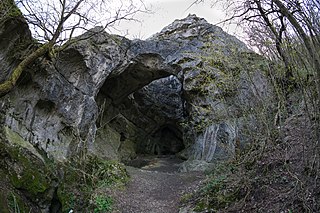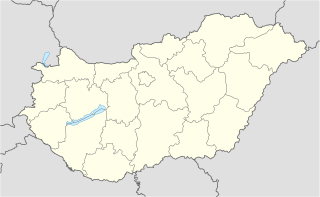Jankovich cave
| Jankovich cave
|
||
|---|---|---|
|
Jankovich cave |
||
| Location: | Bajót , Komárom-Esztergom County , Hungary | |
| Height : | 354 m | |
|
Geographic location: |
47 ° 43 '25.2 " N , 18 ° 34' 31.3" E | |
|
|
||
| Cadastral number: | 4661-1 | |
| Geology: | Banked Dachstein limestone | |
| Type: | Horizontal cave | |
| Lighting: | no | |
| Overall length: | 36 m | |
| Particularities: | Eponymous location | |
The Jankovich Cave ( Hungarian: Jankovich-barlang ) is a 36 meter long karst cave near Bajót in the Gerecse Mountains in Hungary .
It is an eponymous site of the Jankovichien , a local Trans-Danubian expression of the Szeletien .
Geographical location
The Jankovich Cave is located 1.5 km southeast of the village of Bajót on a steep, wooded northern slope of the 374 m high Öreg-kő ( Old Cliff ). Its entrance is 20 m below the summit and can be reached via unpaved forest paths and stairs. The distance to the Danube is 4.2 km as the crow flies .
topography
The horizontally laid out karst cave opens to the north with an approximately 10 m high and 7 m wide, ogival portal. This is followed by the 15 m high Great Hall , the ceiling of which has a circular opening 6 m in diameter. The cave walls are characterized by sloping limestone banks and numerous excavations . In the back part of the cave drops in height by about half and narrows to a several meters wide and deep vault, on the eastern wall of which a side passage branches off. This runs in a southerly direction and ends after 7 m in the so-called dome room with a 5 m high, characteristic vaulted ceiling.
The forecourt of the Jankovich Cave is only a few square meters and is bordered on one side by a limestone wall. Originally it was also part of the cave, but the vault was demolished for industrial purposes before 1913. The entrance to the Lower Grotto, discovered by I. Gaál , is located in a ditch in the eastern corner of the forecourt . It runs under the Jankovich Cave and is connected to it in the front area of the Great Hall .
Research history

|

|
|
|
Leaf tips from radiolarite
|
Engraved pendant
|
Between 1913 and 1918 and 1925, during excavations led by Jenő Hillebrand (1884–1950), a large part of the up to 6 m thick cave sediments were removed. The campaigns were not very systematic and Hillebrand only published incomplete and sometimes contradicting excavation reports on the findings , stratigraphy and location of the recovered artifacts . In addition, he described the strategies in a very undifferentiated manner. In another excavation in 1956, attempts were made to trace the original sequence of layers by making cuts in the remaining sediments, but this was only partially successful.
The excavations in 1913 focused on the rear of the cave. The upper, warm-time layers here were up to 2 m thick and black to gray-brown in color. They contained Bronze Age and Neolithic vessel fragments , several blades and bones from farm animals . This was followed by a yellowish-gray layer of clay with remnants of woolly rhinoceros , reindeer and rodents and a layer of yellow clay mixed with limestone rubble, which mainly contained cave bear bones . A bone needle , a Moustérien point , and a roughly hewn blade point come from these horizons .
In 1915 the side corridor that branches off downwards and filled with yellow and red clay was found. Most of the Early and Middle Paleolithic inventory was found in it and the adjoining dome room , including lithic artefacts, which today are classified as belonging to the Gravettian and Szeletian cultures due to their typology . 104 pieces have the characteristics typical of Jankovichien. The oldest devices are a half-wedge and a scraper from the Moustérien , which were found in 1925 in the lowest of three fireplace horizons in the dome room .
In addition to twelve bone points with a solid or split base, an ivory rod and an amulet decorated with engraved ornaments made of the same material come from the rear part of the cave . Lists of artifacts have only been preserved from the excavations in 1915/16, the handwritten documents are in the Hungarian National Museum in Budapest .
The cave is named after the then Hungarian minister of religion and education, Béla Jankovich (1865–1939), who financially supported the first excavation campaigns.
literature
- András Markó: On the Middle Palaeolithic industrie of the Jankovich cave (Northeastern Transdanubia) . Tanulmányok-Studies, Akadémiai Kiadó, Budapest 2013, pp. 7–28 (English).
- Veronika Gábori-Csánk: Le Jankovichien - Une civilization paléolithique en Hongrie , Companyédition de Études et recherches archéologiques de l'Université de Liège et du Musée historique de Budapest, Budapest 1994, pp. 23-31 (French).
- Ottokár Kadić: Man during the Ice Age in Hungary . Royal Hungarian Geological Institute (Ed.), Budapest 1934, pp. 94–100.
Web links
Individual evidence
- ↑ a b c d Veronika Gábori-Csánk: Le Jankovichien - Une civilization paléolithique en Hongrie . Companyédition de Études et recherches archéologiques de l'Université de Liège et du Musée historique de Budapest, Budapest 1994, p. 32-31 .
- ↑ Ottokár Kadić: Man at the Ice Age in Hungary . Royal Hungarian Geological Institute, Budapest 1934, p. 94-100 .
- ↑ a b c László Vértes, Miklós Kretzoi, Margit Herrmann: Newer research in the Jankovich cave . Folia Archaeologica, Budapest 1957, p. 1-23 .
- ↑ a b c d András Markó: On the Middle Palaeolithic industrie of the Jankovich cave (Northeastern Transdanubia) . Tanulmányok-Studies, Akadémiai Kiadó, Budapest 2013, p. 7-28 .
- ↑ Gerd Albrecht, Joachim Hahn, Wolfgang G. Torke: Characteristic analysis of bullet tips of the middle Young Pleistocene in Central and Eastern Europe . Verlag W. Kohlhammer, Stuttgart 1972, p. 19 .
- ↑ László Vértes: Quaternary year 1960: The Paleolithic Age of the southern Danube regions . Verlag Marie Leidorf, Rahden 1960, p. 76-91 .




